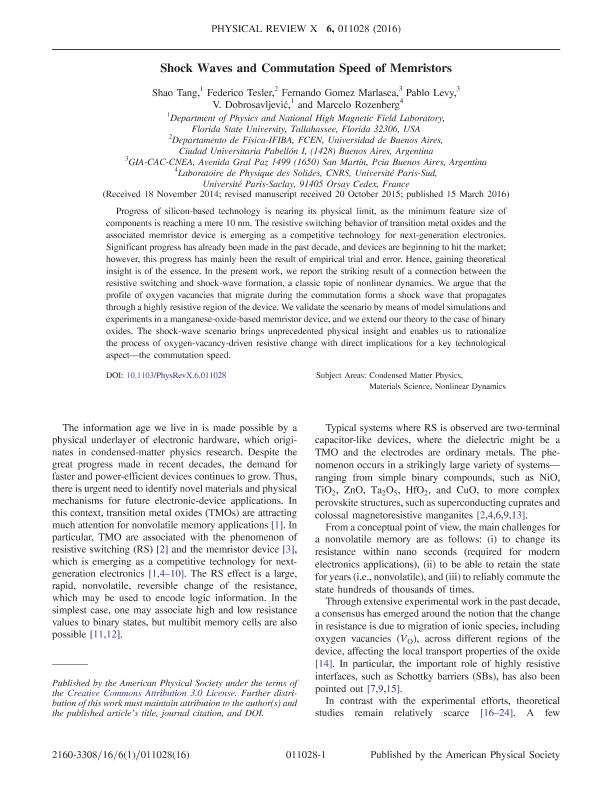Mostrar el registro sencillo del ítem
dc.contributor.author
Tang, Shao
dc.contributor.author
Tesler, Federico Ariel

dc.contributor.author
Gomez Marlasca, Fernando

dc.contributor.author
Levy, Pablo Eduardo

dc.contributor.author
Dobrosavljevic, V.
dc.contributor.author
Rozenberg, Marcelo Javier

dc.date.available
2020-09-17T20:43:15Z
dc.date.issued
2016-03
dc.identifier.citation
Tang, Shao; Tesler, Federico Ariel; Gomez Marlasca, Fernando; Levy, Pablo Eduardo; Dobrosavljevic, V.; et al.; Shock waves and commutation speed of memristors; American Physical Society; Physical Review X; 6; 1; 3-2016; 11028-11028
dc.identifier.issn
2160-3308
dc.identifier.uri
http://hdl.handle.net/11336/114261
dc.description.abstract
Progress of silicon-based technology is nearing its physical limit, as the minimum feature size of components is reaching a mere 10 nm. The resistive switching behavior of transition metal oxides and the associated memristor device is emerging as a competitive technology for next-generation electronics. Significant progress has already been made in the past decade, and devices are beginning to hit the market; however, this progress has mainly been the result of empirical trial and error. Hence, gaining theoretical insight is of the essence. In the present work, we report the striking result of a connection between the resistive switching and shock-wave formation, a classic topic of nonlinear dynamics. We argue that the profile of oxygen vacancies that migrate during the commutation forms a shock wave that propagates through a highly resistive region of the device. We validate the scenario by means of model simulations and experiments in a manganese-oxide-based memristor device, and we extend our theory to the case of binary oxides. The shock-wave scenario brings unprecedented physical insight and enables us to rationalize the process of oxygen-vacancy-driven resistive change with direct implications for a key technological aspect-the commutation speed.
dc.format
application/pdf
dc.language.iso
eng
dc.publisher
American Physical Society

dc.rights
info:eu-repo/semantics/openAccess
dc.rights.uri
https://creativecommons.org/licenses/by-nc-sa/2.5/ar/
dc.subject
Shockwaves
dc.subject
memristors
dc.subject.classification
Física de los Materiales Condensados

dc.subject.classification
Ciencias Físicas

dc.subject.classification
CIENCIAS NATURALES Y EXACTAS

dc.title
Shock waves and commutation speed of memristors
dc.type
info:eu-repo/semantics/article
dc.type
info:ar-repo/semantics/artículo
dc.type
info:eu-repo/semantics/publishedVersion
dc.date.updated
2020-09-08T13:58:43Z
dc.journal.volume
6
dc.journal.number
1
dc.journal.pagination
11028-11028
dc.journal.pais
Estados Unidos

dc.description.fil
Fil: Tang, Shao. National High Magnetic Field Laboratory; Estados Unidos
dc.description.fil
Fil: Tesler, Federico Ariel. Consejo Nacional de Investigaciones Científicas y Técnicas. Oficina de Coordinación Administrativa Ciudad Universitaria. Instituto de Física de Buenos Aires. Universidad de Buenos Aires. Facultad de Ciencias Exactas y Naturales. Instituto de Física de Buenos Aires; Argentina
dc.description.fil
Fil: Gomez Marlasca, Fernando. Comisión Nacional de Energía Atómica; Argentina
dc.description.fil
Fil: Levy, Pablo Eduardo. Comisión Nacional de Energía Atómica; Argentina. Consejo Nacional de Investigaciones Científicas y Técnicas; Argentina
dc.description.fil
Fil: Dobrosavljevic, V.. National High Magnetic Field Laboratory; Estados Unidos
dc.description.fil
Fil: Rozenberg, Marcelo Javier. Université Paris Sud; Francia. Consejo Nacional de Investigaciones Científicas y Técnicas; Argentina
dc.journal.title
Physical Review X

dc.relation.alternativeid
info:eu-repo/semantics/altIdentifier/url/http://journals.aps.org/prx/abstract/10.1103/PhysRevX.6.011028
dc.relation.alternativeid
info:eu-repo/semantics/altIdentifier/doi/http://dx.doi.org/10.1103/PhysRevX.6.011028
Archivos asociados
